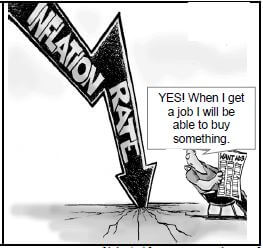ECONOMICS PAPER 2 GRADE 12 QUESTIONS - NSC EXAMS PAST PAPERS AND MEMOS NOVEMBER 2018
Share via Whatsapp Join our WhatsApp Group Join our Telegram GroupECONOMICS
PAPER 2
GRADE 12
NSC EXAMS
PAST PAPERS AND MEMOS NOVEMBER 2018
INSTRUCTIONS AND INFORMATION
- Answer FOUR questions as follows in the ANSWER BOOK:
SECTION A: COMPULSORY
SECTION B: Answer TWO of the three questions.
SECTION C: Answer ONE of the two questions. - Answer only the required number of questions. Answers in excess of the required number will NOT be marked.
- Number the answers correctly according to the numbering system used in this question paper.
- Write the question number above each answer.
- Read the questions carefully.
- Start EACH question on a NEW page.
- Leave 2–3 lines between subsections of questions.
- Answer the questions in full sentences and ensure that the format, content and context of your responses comply with the cognitive requirements of the questions.
- Use only black or blue ink.
- You may use a non-programmable pocket calculator.
- Write neatly and legibly.
QUESTIONS
SECTION A (COMPULSORY)
QUESTION 1 30 MARKS – 20 MINUTES
1.1 Various options are provided as possible answers to the following questions. Choose the answer and write only the letter (A–D) next to the question numbers (1.1.1 to 1.1.8) in the ANSWER BOOK, e.g. 1.1.9 D.
1.1.1 Unit cost is also known as … cost.
- marginal
- total
- average
- variable
1.1.2 The nature of the product traded in a pure oligopoly is …
- differentiated.
- homogenous.
- heterogeneous.
- unique.
1.1.3 The term 'long run' refers to a period where … factors of production can change.
- both variable and fixed
- only variable
- only fixed
- floating
1.1.4 A fresh-produce market is a good example of a/an … market structure.
- monopolistic competitive
- monopoly
- perfect competitive
- oligopoly
1.1.5 The Minister of … is responsible for fiscal policy to stabilise the economy.
- Tourism
- Finance
- Trade
- Environmental Affairs
1.1.6 The government can levy a/an … tax on environmental polluters.
- import
- personal income
- consumption
- green
1.1.7 The tourism industry is … intensive.
- capital
- money
- technology
- labour
1.1.8 The granting of a licence to businesses that allow them to pollute up to a certain degree is referred to as …
- marketable permits.
- legislation.
- taxable permits.
- licencing. (8 x 2) (16)
1.2 Choose a description from COLUMN B that matches the item in COLUMN A. Write only the letter (A–I) next to the question numbers (1.2.1 to 1.2.8) in the ANSWER BOOK.
COLUMN A | COLUMN B |
1.2.1 Pareto efficiency |
(8 x 1) (8) |
1.3 Give ONE term for each of the following descriptions. Write only the term next to the question numbers (1.3.1 to 1.3.6) in the ANSWER BOOK. Abbreviations, acronyms and examples will NOT be accepted.
1.3.1 The cost that remains the same even if the output changes
1.3.2 A market structure where the individual firms are price-takers
1.3.3 The additional revenue earned when sales increase by one more unit
1.3.4 Low growth, high unemployment and high inflation rates occur simultaneously
1.3.5 The type of tourism where tourists come to South Africa to visit museums and art galleries
1.3.6 Resources that can be replaced or regenerated (6 x 1) (6)
TOTAL SECTION A: 30
SECTION B
Answer any TWO of the three questions in this section in the ANSWER BOOK.
QUESTION 2: MICROECONOMICS 40 MARKS – 30 MINUTES
2.1 Answer the following questions.
2.1.1 Give any TWO examples of natural monopolies. (2 x 1) (2)
2.1.2 What is the main purpose of markets in the economy? (1 x 2) (2)
2.2 Study the extract below and answer the questions that follow.
NEW AMENDMENTS TO COMPETITION ACT The government introduced the Competition Act, 1998 (Act 89 of 1998) to promote competition and enhance the efficiency of the South African economy. The Competition Commission, Competition Tribunal and Competition Appeal Court play an important role in the administration of the Act. [Adapted from Businesstech.co.za, 2016] |
2.2.1 Which institution imposes fines on companies that are guilty of collusion? (1)
2.2.2 What is the role of the Competition Appeal Court? (1)
2.2.3 State any ONE aim of the competition policy. (2)
2.2.4 How does competition in the market benefit the consumer? (2)
2.2.5 Briefly discuss the success of the competition policy of South Africa. (2 x 2) (4)
2.3 Study the graph below and answer the questions that follow. 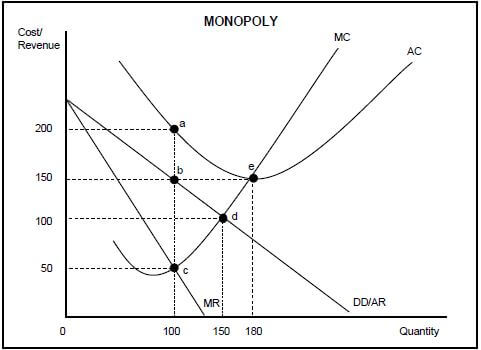
2.3.1 What is the selling price of the business above? (1)
2.3.2 Identify the letter in the graph above that represents the loss minimising point. (1)
2.3.3 Briefly describe the term monopoly. (2)
2.3.4 Why is the equilibrium position above typical of the short run? (2)
2.3.5 Determine the loss for this business. Show ALL calculations. (4)
2.4 With the aid of a well-labelled graph (cost and revenue curves), explain the shut-down point for the individual firm in a perfect market. (8)
2.5 Evaluate the impact of collusion on the economy. (8) [40]
QUESTION 3: CONTEMPORARY ECONOMIC ISSUES 40 MARKS – 30 MINUTES 3.1
Answer the following questions.
3.1.1 Give any TWO examples of consumer inflation. (2 x 1) (2)
3.1.2 What is the main purpose of preservation? (1 x 2) (2)
3.2 Study the information below and answer the questions that follow.
SOUTH AFRICA'S INFLATION REACHES ITS LOWEST LEVEL SINCE 2015 South African food prices grew at a slower rate in July 2017 than in June 2017. In June the general price level increased by 5,1%, while in July it increased by 4,6%. This led to the Reserve Bank reducing its repo (repurchase) rate by 50 base points. This was a major change from 2012 when the inflation rate was 6,5%. |
|
[Adapted from www.google.co.za]
3.2.1 Identify, in the information above, the inflation rate that falls outside the inflation target range. (1)
3.2.2 Give ONE reason for the decrease in the inflation rate. (1)
3.2.3 Briefly describe the term repo (repurchase) rate. (2)
3.2.4 How will a decrease in the inflation rate benefit low-income earners? (2)
3.2.5 How can price stability affect the economy positively? (2 x 2) (4)
3.3 Study the cartoon below and answer the questions that follow. 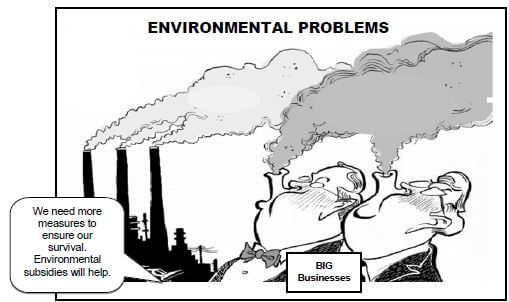
[Source: www.wikipedia, 2017]
3.3.1 Identify the type of pollution in the cartoon above. (1)
3.3.2 What major environmental problem can result from the business activities above? (1)
3.3.3 Briefly describe the term environmental sustainability. (2)
3.3.4 What impact will environmental problems have on food security (continuous food production)? (2)
3.3.5 How can environmental subsidies be used to ensure sustainable development in South Africa? (2 x 2) (4)
3.4 Briefly discuss demand-pull inflation and cost-push inflation. (2 x 4) (Maximum 4 marks each) (8)
3.5 Why have the international measures (agreements) been ineffective in reducing the effects of climate change? (8) [40]
QUESTION 4: MICROECONOMICS AND CONTEMPORARY ECONOMIC ISSUES 40 MARKS – 30 MINUTES
4.1 Answer the following questions.
4.1.1 Give any TWO examples of hazardous waste that affects the environment. (2 x 1) (2)
4.1.2 Why are merit goods normally undersupplied by the market? (1 x 2) (2)
4.2 Study the extract below and answer the questions that follow.
FAST-FOOD RESTAURANTS IN THE MONOPOLISTIC South Africa's fast-food market is extremely competitive, as many sellers fight it out for their share of the consumer market. The fast-food industry accounts for about 40% of the total consumer food-service sales in South Africa, e.g. Fishaways selling fish and Steers selling hamburgers. It is regarded as a hybrid market structure. [Adapted from City Press, February 2017] |
4.2.1 Give ONE example of a monopolistic competitor that specialises only in chicken. (1)
4.2.2 Identify the concept that describes a combination of perfect competition and monopoly. (1)
4.2.3 Why does branding play a major role in monopolistic competition? (2)
4.2.4 Give a reason why businesses in the monopolistic competitive market prefer to compete on a non-price basis. (2)
4.2.5 Why will the economic profit made by a monopolistic competitor disappear in the long run? (2 x 2) (4)
4.3 Study the information below and answer the questions that follow. 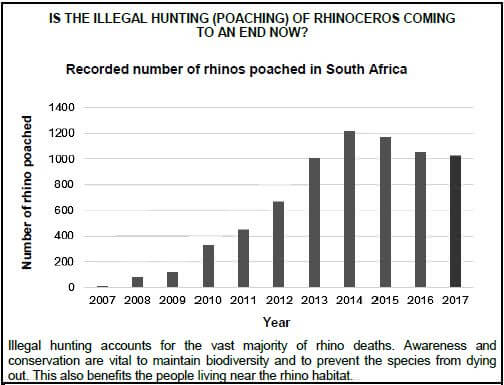
[Adapted from www.PoachStatsSA, 2017]
4.3.1 What is the main reason for the poaching of rhinos? (1)
4.3.2 In which year was rhino poaching at its worst in South Africa? (1)
4.3.3 Briefly describe the term biodiversity. (2)
4.3.4 Give ONE example of how awareness of the natural fauna and flora can be created. (2)
4.3.5 How will conservation benefit the people living near the rhino habitat? (2 x 2) (4)
4.4 With the aid of graphs, briefly explain how price is determined for an individual producer in a perfect market. (8)
4.5 How can South African households contribute to a lower inflation rate? (8) [40]
TOTAL SECTION B: 80
SECTION C
Answer any ONE of the two questions in this section in the ANSWER BOOK.
Ensure that your answer follows the structure indicated below in order to obtain maximum marks:
STRUCTURE OF ESSAY | MARK ALLOCATION |
Introduction
| Max. 2 |
Body | Max. 26 Max. 10 |
Conclusion
| Max. 2 |
TOTAL | 40 |
QUESTION 5: MICROECONOMICS 40 MARKS – 40 MINUTES
- Discuss, with the aid of graphs, the consequences of market failure under the following headings:
- Producer subsidies (8 marks)
- Maximum prices (8 marks)
- Minimum wages (10 marks) (26 marks)
- With reference to the graph below, analyse how a negative externality can result in the misallocation of resources.
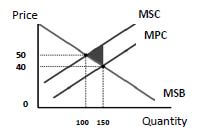
QUESTION 6: CONTEMPORARY ECONOMIC ISSUES 40 MARKS – 40 MINUTES
- Discuss the effects of tourism. (26 marks)
- Evaluate the success of indigenous knowledge systems (IKS) in promoting tourism in South Africa. (10 marks) [40]
TOTAL SECTION C: 40
GRAND TOTAL: 150
